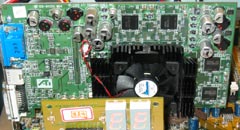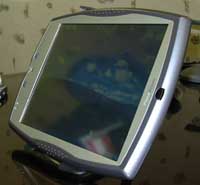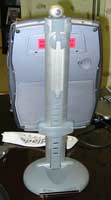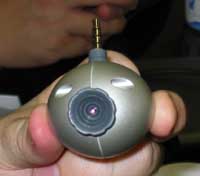
Original Link: https://www.anandtech.com/show/924
Computex 2002 Day 3: More ATI, VIA & PaceBlade
by Anand Lal Shimpi on June 5, 2002 11:48 AM EST- Posted in
- Trade Shows
Things are finally winding down after a very intense few days at Computex 2002. Our thirdday of coverage comes lightly as we attempt to finish off our last few meetings and engagements before we embark on the long series of flights back home.
There's much more to come however once we get back, but to tide you over between now and then here we have Day 3 of Computex 2002.
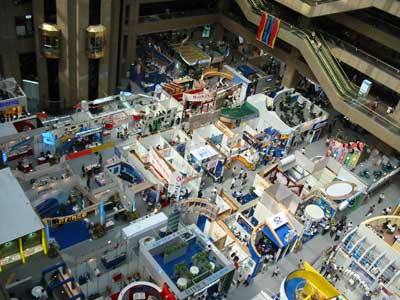
ATI's R300 - 10 Layer PCB?
This information was available first through the AnandTech Newsletter. Click Here to Subscribe.
We've been talking to a lot of the manufacturers that make boards for ATI and although there isn't a strong ATI presence on the show floor, there are a number of gems running behind closed doors. Yesterday we brought our Newsletter subscribers the first look at ATI's successor to the Radeon 8500 (R200) - the R300 chip running at VIA's suite. In that article we hypothesized that ATI's next-generation chip may indeed be built on a 0.15-micron process and today we received some interesting information that may support that theory.
While talking to one of ATI's board partners we were informed that they weren't keen on building R300 boards because of the fact that they are expecting the design to require a 10-layer PCB. We could not get confirmation as to whether or not ATI's R300 board running in VIA's suite was a 10-layer board or not but according to this board manufacturer, they will only be distributing R300 boards and not producing them.
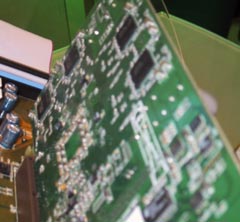
The need for a 10-layer PCB comes from increased power consumption where separating power and ground layers becomes difficult and thus requiring the use of more board layers to route traces through. With the amount of power that the 8-layer GeForce4 Ti 4400/4600 boards draw, we wouldn't expect much less from a next-generation part from ATI that is supposed to significantly outperform the GeForce4.
RV250 - Technically ready for a while
This information was available first through the AnandTech Newsletter. Click Here to Subscribe.
We've already been briefed under NDA on ATI's RV250 part so we cannot share the majority of material about the RV250 chip but we can definitely offer what we've learned today.
The RV250 chip will be the mainstream part that will take over once the R300 launches. While we can't disclose the specific specifications of the part, our board manufacturing contacts today informed us that the performance of the RV250 is very close to that of the R200 (Radeon 8500). This obviously means that the RV250 will not only make the Radeon 8500LE obsolete but it will also make the Radeon 8500 useless as well. Apparently ATI has had the RV250 ready for a while but they didn't want to kill Radeon 8500 sales so they held off on releasing it until closer to R300's launch. Considering the chip will be a mainstream product we can expect it to sell on boards for around the $199 price point.
The architecture is very similar to R200 (DX8 part) with a few things removed and core clock speeds are expected to be close to 300MHz according to our sources today. At 300MHz the RV250 has the potential of being tough competition for the GeForce4 Ti 4200, but we'll have to wait for its launch before we can decide for certain.
ATI & VIA - The Fiasco
Yesterday we brought you pictures of ATI's R300 running in VIA's booth and as we originally guessed it, VIA shouldn't have been showing off the card. It turns out that ATI ended up getting quite upset with VIA but in the end the running R300 card should have been embraced by ATI as some very good PR. Today a visit to VIA's booth revealed an ASUS GeForce2 card running in place of the R300.
To those at ATI that were worried about VIA bragging about having R300 in their suite, VIA did nothing of the sort. We recognized the board as something other than R200 or RV250 and thus inquired a bit further but for the most part VIA was simply calling it an 8X AGP card by ATI.
Is there any reason for ATI to be irritated with VIA over this? We can understand why, but at the same time, as long as no benchmarks were released and the system was running reliably there's no reason for ATI to be worried. In fact, if anything, this helps validate ATI's quiet message that they are significantly ahead of NV30 in terms of development. Interestingly enough, while the R300 equipped KT400 system was running just fine yesterday, today we witnessed it bluescreen with the GeForce2 installed. Go figure.
Although we're hearing from more and more people that R300 will be 0.15-micron based, we're also hearing that ATI's confidence in its performance is not misplaced. We won't comment any further but a combination of what we heard when we toured ATI a few weeks ago, John Carmack's comments at E3 and the most recent events give ATI infinitely more credibility when it comes to their claims about R300.
Should VIA have been running R300 in their booth? No. Was any harm done by it being there? Look at what AMD is doing with Hammer which is even further away than R300 from being released and tell us if a confident display of a product running is harmful press.
PaceBlade - Advancing the PaceBook
We got quite a positive response from our PaceBlade PaceBook review published a few weeks ago. As you may recall, the PaceBook is a 3-in-1 PC solution, offering the functionality of an LCD PC, a notebook, and a tablet PC all in one. We met up with PaceBlade at Computex to see what they have in store for the PaceBook solution.
One thing that PaceBlade made clear was that the PaceBook is an evolving product. Since the PaceBook is based off an extremely new and unique concept, getting everything perfect off the bat is hard. Rather than abandon the cause or design a new product, PaceBlade is working to improve existing and future PaceBook models by brining extra functionality to the solution. The demonstrations we saw today reflected upon that.
Perhaps the most exciting thing out of PaceBlade is something that we could see but only hear about. It seems that the PaceBook handwriting recognition software is in the very final stages of development and should be ready to ship in a week or twos time. There is no question that handwriting capabilities will drastically increase the usability of the PaceBook (by making it a viable tablet solution) and we can't wait to get our hands on the software.
PaceBlade was demonstrating a number of upcoming accessories that will take the PaceBook to new levels of productivity and usability. We will only briefly talk about a handful of the items we saw today but keep an eye out for an article in the coming weeks reviewing not only the new PaceBook accessories but also the handwriting software and the various updates that the PaceBook is getting.
One accessory we saw is going to become standard equipment for all PaceBooks going out. PaceBlade admitted that using the system's case as a desk stand was far from ideal. To solve the problem, the PaceBook now comes with a small stand that can hold the unit in portrait or landscape mode for desktop use. This should make office life with the PaceBook easier.
Although the small stand may serve as a better LCD PC stand than the soft case, it is still not very desktop-like in nature. To make the PaceBook feel even more at home on the desk, PaceBlade has designed an office stand that holds the unit at a comfortable height. Cost is yet to be finalized but should be around $100 with an included USB hub in the unit's back.
Finally we will show you the first Peripheral to make use of the PaceBook's round USB port. The PaceBook camera is a USB video camera that can act as a web cam or a still cam. Because it attaches to the PaceBook's round USB port, it can swivel in any direction and can tilt 40 degrees vertically.
Again, the thing that we got out of our PaceBlade meeting is that they are definitely committed to the product and are going to keep tweaking the hardware and software until things are perfect. We will provide you with more detailed information on the products above and more when we get them.
What's Coming
After a tour of ASUS' mobile manufacturing plant tomorrow we will be headed back home, but there's still much to report. Here's an idea of what we're working on for publication when we get back:
Inside VIA
Motherboards in 2H-2002 Preview
and of course there are the other projects we had to drop in order to fly out to Computex which we will be picking up when we get back. Those include:
Inside ATI
Intel 845G Motherboard Roundup
VIA KT333 Motherboard Roundup
Dell Latitude C840
WinBook J4
We hope you enjoyed our Computex coverage both on the main site and in the Newsletter and as soon as we're back in the States it will be back to work.

